

Cerence Q1FY23 Earnings Presentation Stefan Ortmanns, CEO Tom Beaudoin, CFO Rich Yerganian, SVP of Investor Relations February 8, 2023 Destination Next Exhibit 99.2

Forward-Looking Statements Statements in this presentation regarding: Cerence’s future performance, results and financial condition; expected growth; multi-year targets; opportunities; business, industry and market trends; strategy regarding fixed contracts and its impact on financial results; backlog; demand for Cerence products; innovation and new product offerings; cost efficiency initiatives; and management’s future expectations, beliefs, goals, plans or prospects constitute forward-looking statements within the meaning of the Private Securities Litigation Reform Act of 1995. Any statements that are not statements of historical fact (including statements containing the words “believes,” “plans,” “anticipates,” “expects,” “intends” or “estimates” or similar expressions) should also be considered to be forward-looking statements. Although we believe forward-looking statements are based upon reasonable assumptions, such statements involve known and unknown risk, uncertainties and other factors, which may cause actual results or performance of the company to be materially different from any future results or performance expressed or implied by such forward-looking statements including but not limited to: the highly competitive and rapidly changing market in which we operate; adverse conditions in the automotive industry, the related supply chain and semiconductor shortage, or the global economy more generally; the impacts of the COVID-19 pandemic on our and our customers’ businesses; the impact of the war in Ukraine on our and our customers’ businesses; our ability to control and successfully manage our expenses and cash position; escalating pricing pressures from our customers; the impact on our business of the transition to a lower level of fixed contracts, including the failure to achieve such a transition; our failure to win, renew or implement service contracts; the cancellation or postponement of existing contracts; the loss of business from any of our largest customers; effects of customer defaults; our inability to successfully introduce new products, applications and services; our strategy to increase cloud offerings; the inability to recruit and retain qualified personnel; disruptions arising from transitions in management personnel; cybersecurity and data privacy incidents; fluctuating currency rates and interest rates; inflation; and the other factors discussed in our most recent Annual Report on Form 10-K for the fiscal year ended September 30, 2022, quarterly reports on Form 10-Q, and other filings with the Securities and Exchange Commission.

Strong Core Business drives revenue and profitability Introduced strategy “Destination Next” and long-term model at our investor day in November Strong market position delivers two win-backs and two new logos Macro environment incrementally better but risks persist Continued confidence in FY23 business outlook Q1 FY23 Business Highlights
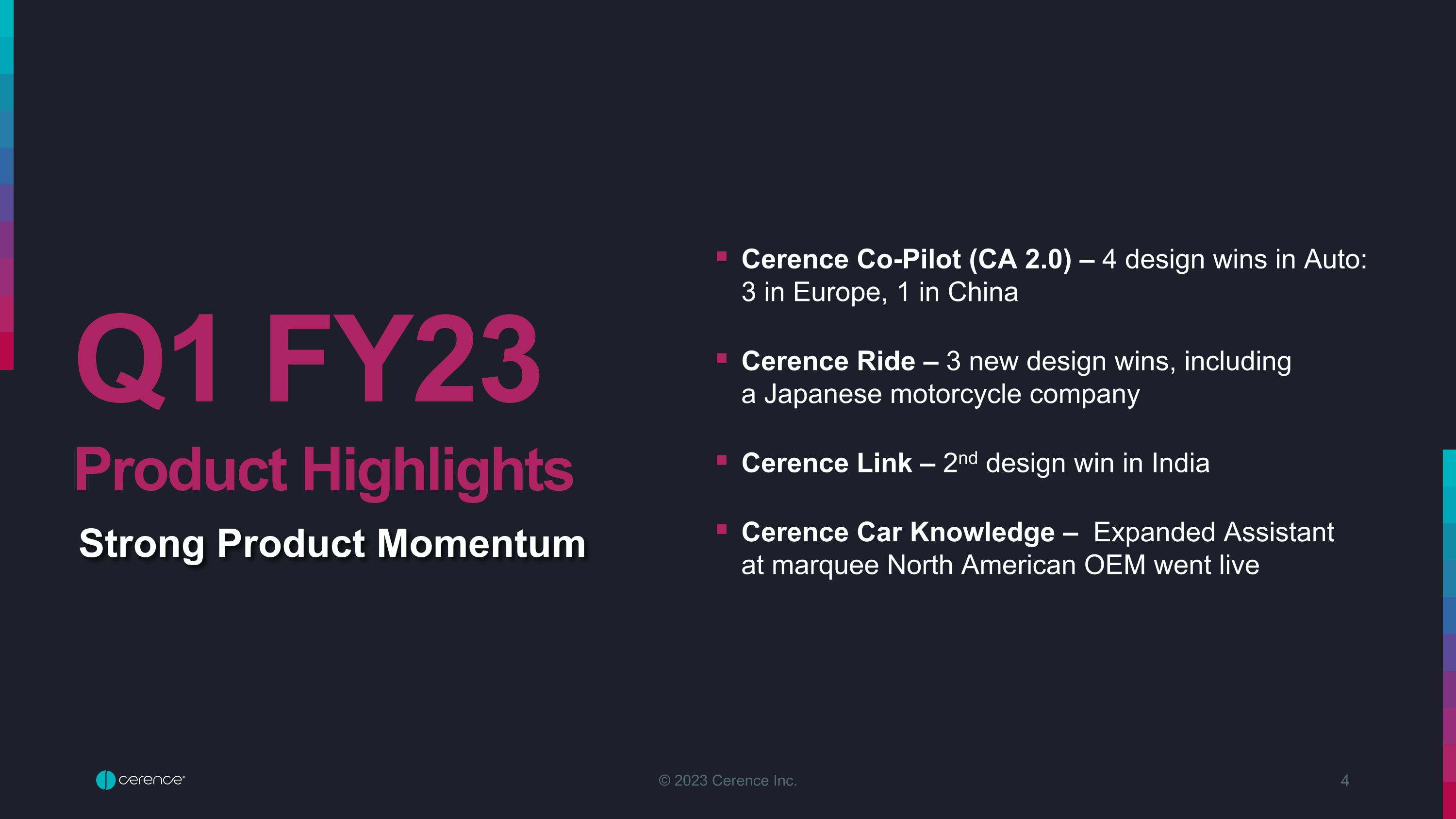
Cerence Co-Pilot (CA 2.0) – 4 design wins in Auto: 3 in Europe, 1 in China Cerence Ride – 3 new design wins, including a Japanese motorcycle company Cerence Link – 2nd design win in India Cerence Car Knowledge – Expanded Assistant at marquee North American OEM went live Q1 FY23 Product Highlights Strong Product Momentum
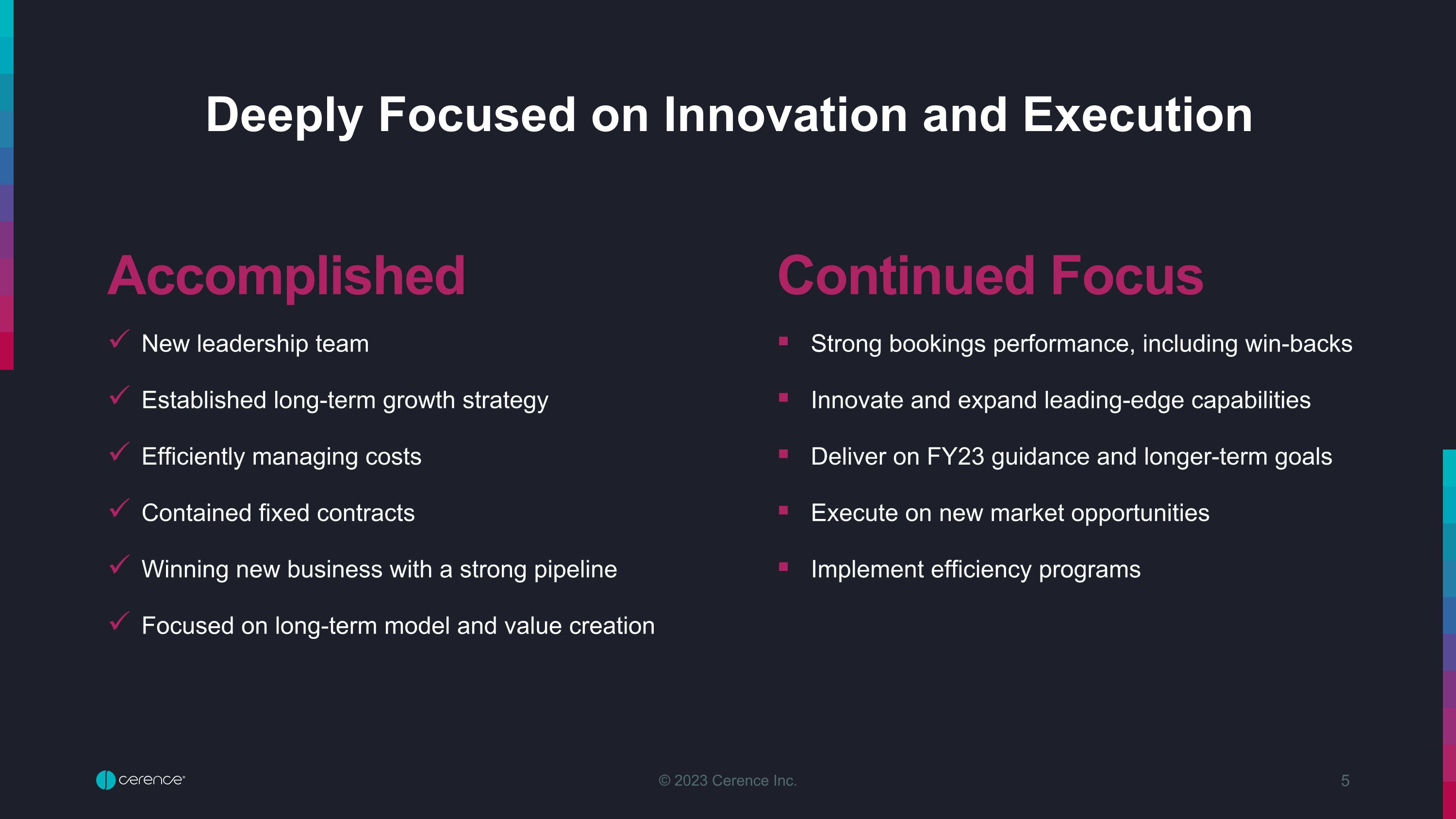
Deeply Focused on Innovation and Execution New leadership team Established long-term growth strategy Efficiently managing costs Contained fixed contracts Winning new business with a strong pipeline Focused on long-term model and value creation Accomplished Continued Focus Strong bookings performance, including win-backs Innovate and expand leading-edge capabilities Deliver on FY23 guidance and longer-term goals Execute on new market opportunities Implement efficiency programs
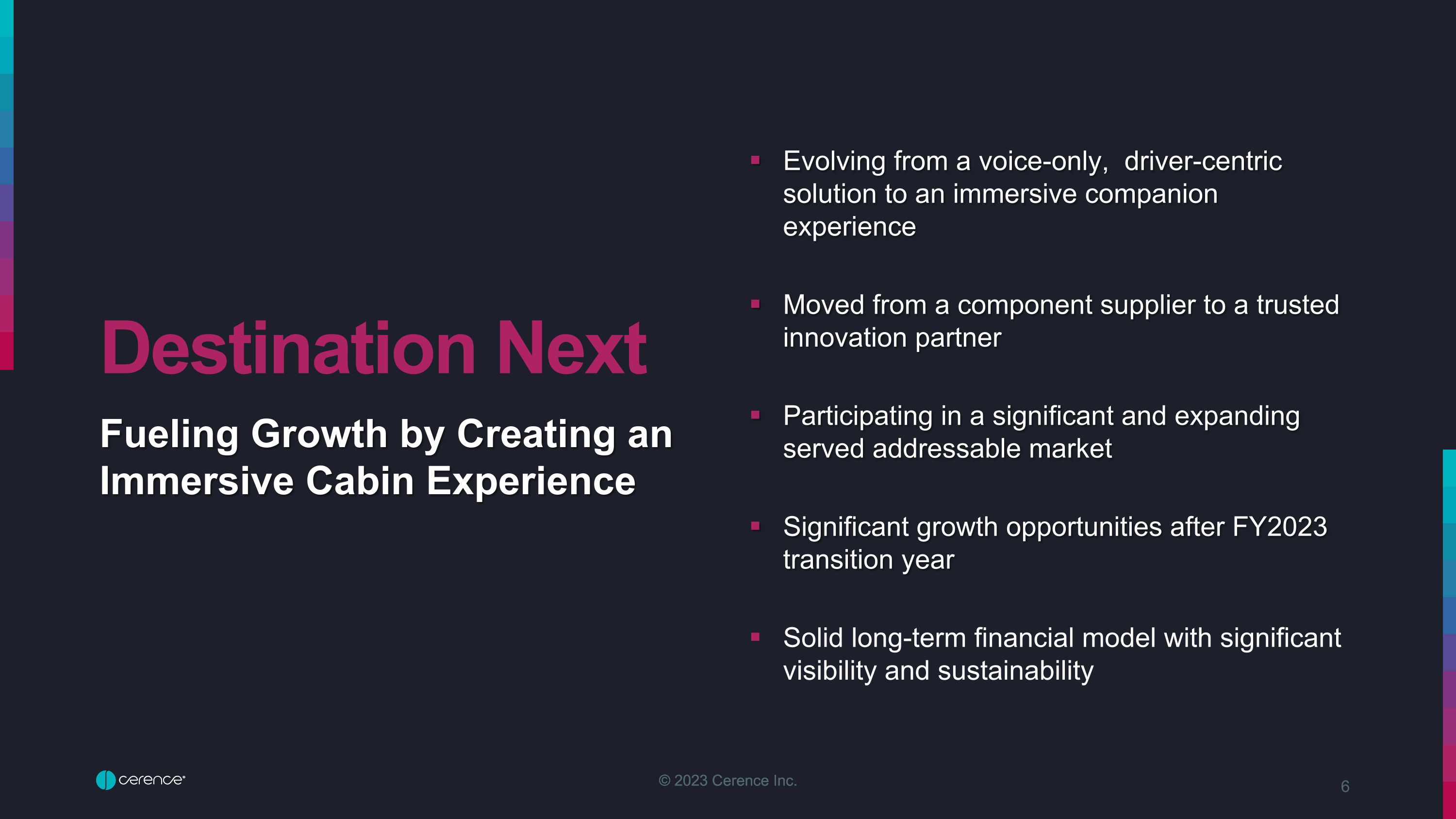
© 2023 Cerence Inc. Evolving from a voice-only, driver-centric solution to an immersive companion experience Moved from a component supplier to a trusted innovation partner Participating in a significant and expanding served addressable market Significant growth opportunities after FY2023 transition year Solid long-term financial model with significant visibility and sustainability Destination Next Fueling Growth by Creating an Immersive Cabin Experience 6

Q1FY23 Financial Details Tom Beaudoin, CFO Destination Next
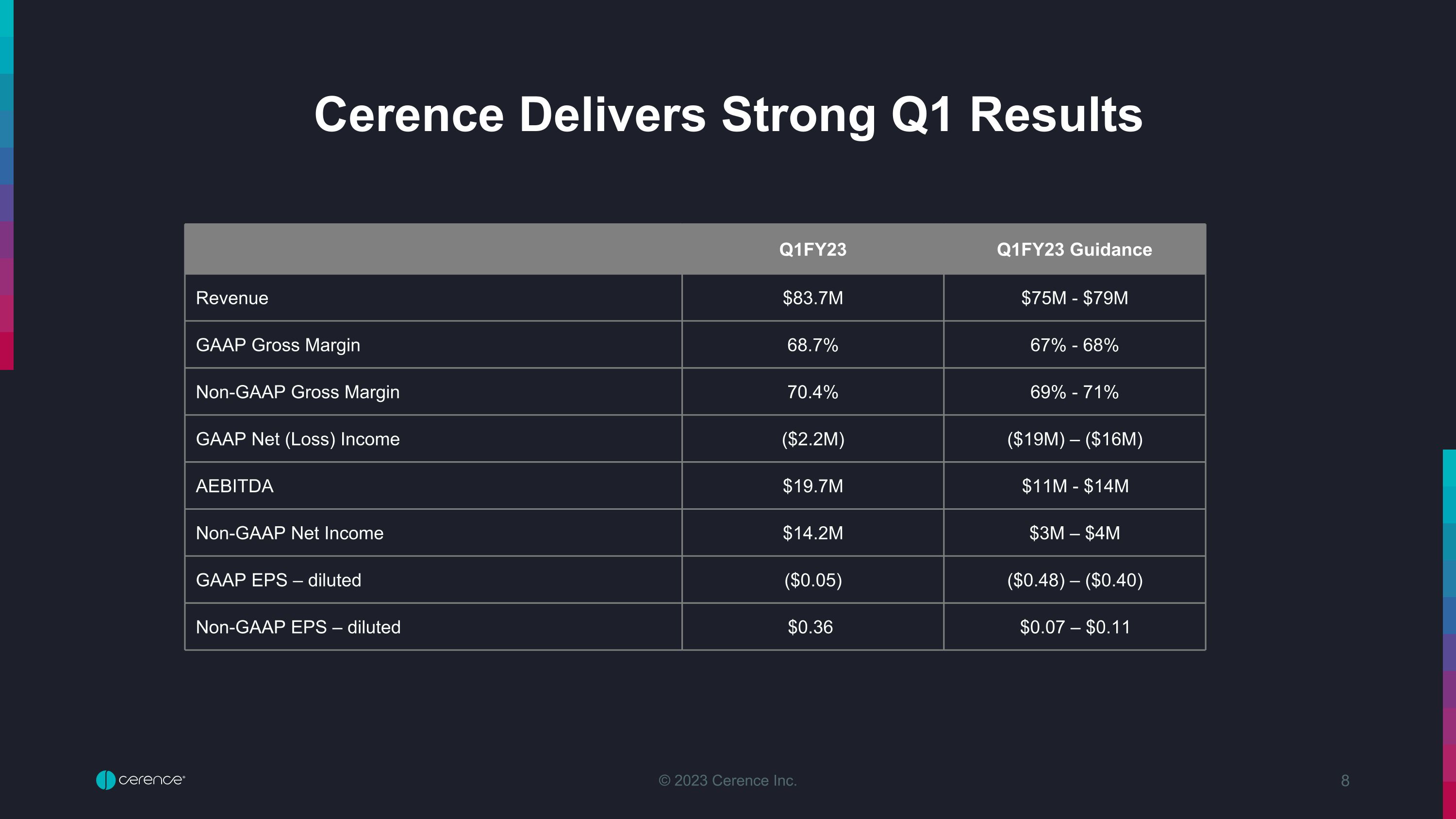
Cerence Delivers Strong Q1 Results Q1FY23 Q1FY23 Guidance Revenue $83.7M $75M - $79M GAAP Gross Margin 68.7% 67% - 68% Non-GAAP Gross Margin 70.4% 69% - 71% GAAP Net (Loss) Income ($2.2M) ($19M) – ($16M) AEBITDA $19.7M $11M - $14M Non-GAAP Net Income $14.2M $3M – $4M GAAP EPS – diluted ($0.05) ($0.48) – ($0.40) Non-GAAP EPS – diluted $0.36 $0.07 – $0.11

In millions Q1FY22 Q2FY22 Q3FY22 Q4FY22 Q1FY23 Total License: $46.8 $46.3 $46.4 $19.0 $45.4 Variable(a) $21.5 $20.2 $22.3 $19.0 $26.3 Total Fixed(b) $20.1 $25.6 $23.3 $0 $19.1 Prepaid (cash upfront) - $5.7 $13.2 -- $18.0 Minimum Commitment (no cash upfront) $20.1 $19.9 $10.1 -- $1.1 Other Markets(c) $5.2 $0.5 $0.8 $0 $0 Connected Services: $28.2 $19.3 $20.0 $18.1 $18.4 Total New $12.2 $11.0 $11.6 $9.6 $9.9 Subscription/Usage $11.3 $11.0 $9.9 $9.6 $9.9 Customer Hosted(d) $0.9 - $1.7 - - Legacy(e) $16.0 $8.3 $8.4 $8.5 $8.5 Professional Services $19.4 $20.7 $22.6 $21.0 $19.9 Total Revenue: $94.4 $86.3 $89.0 $58.1 $83.7 (a) Based on volume shipments of licenses net of the consumption of fixed contracts. (b) Fixed license revenue includes prepaid and minimum commitment deals. (c) Non-automotive revenue. (d) Customer Hosted is a software license that allows the customer to take possession of the software and enable hosting by the customer or a third party. (e) Legacy contract is a connected services contract with Toyota acquired by Nuance through a 2013 acquisition. Detailed GAAP Revenue Breakdown

In millions FY2021 Fiscal Year 2021 FY2022 FY2023 Q1 Q2 Q3 Q4 Q1 Q2 Q3 Q4 Q1 Fixed Contracts $10.1 $17.3 $18.2 $25.4 $20.1 $25.6 $23.3 $0 $19.1 Pro Forma Royalties(a) $48.6 $47.4 $42.9 $34.0 $39.6 $39.7 $41.5 $39.1 $41.7 Consumption of Fixed Contracts(b) ($12.3) ($10.3) ($11.1) ($13.2) ($18.0) ($19.5) ($19.2) ($20.1) ($15.4) Variable (as reported) $36.3 $37.1 $31.8 $20.8 $21.6 $20.2 $22.3 $19.0 $26.3 IHS Production (million units) 23.6 20.7 18.8 16.6 21.2 20.0 19.1 21.2 21.5 ($ millions) (a) Pro forma Royalties is a measure of the total value of licenses shipped in a quarter. (b) Licenses shipped in the quarter associated with fixed contracts. License Business Remains Strong Pro forma royalties remain solid Consumption rate of fixed contracts peaks in FY23 Return to historical levels of approximately $40 million of fixed contracts annually will lead to strong reported license growth in FY24
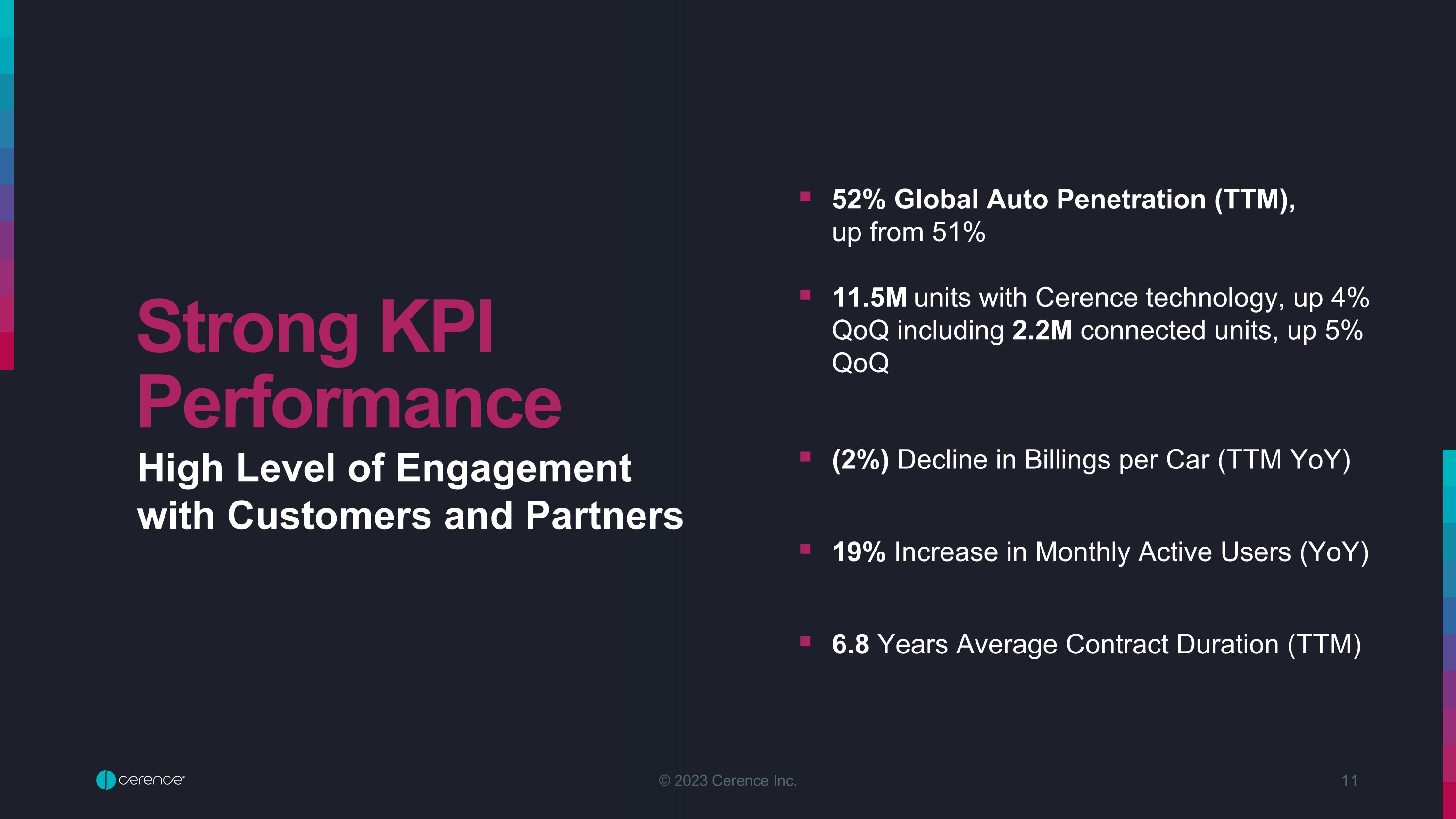
Strong KPI Performance 52% Global Auto Penetration (TTM), up from 51% 11.5M units with Cerence technology, up 4% QoQ including 2.2M connected units, up 5% QoQ (2%) Decline in Billings per Car (TTM YoY) 19% Increase in Monthly Active Users (YoY) 6.8 Years Average Contract Duration (TTM) High Level of Engagement with Customers and Partners
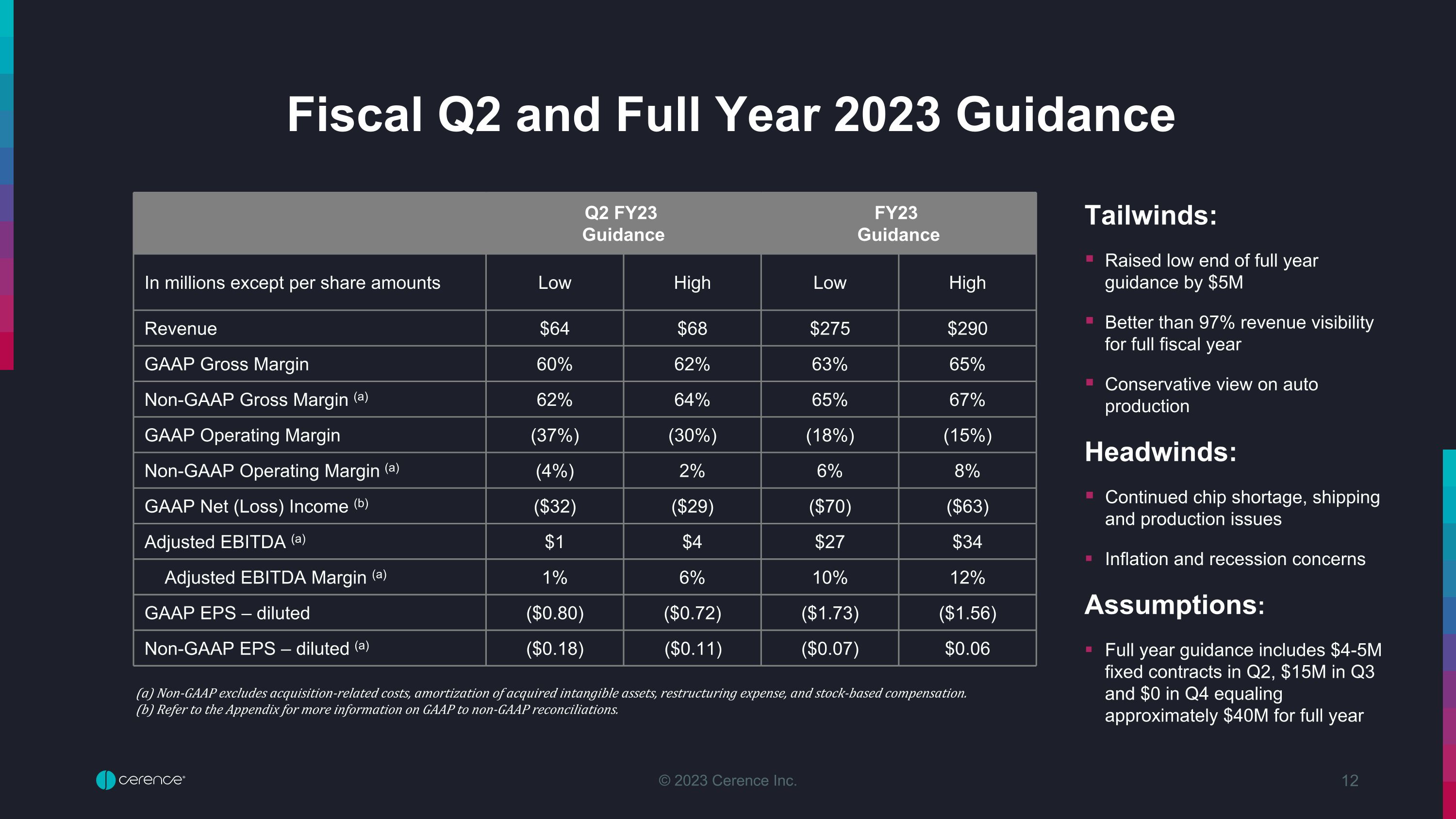
Fiscal Q2 and Full Year 2023 Guidance Q2 FY23 Guidance FY23 Guidance In millions except per share amounts Low High Low High Revenue $64 $68 $275 $290 GAAP Gross Margin 60% 62% 63% 65% Non-GAAP Gross Margin (a) 62% 64% 65% 67% GAAP Operating Margin (37%) (30%) (18%) (15%) Non-GAAP Operating Margin (a) (4%) 2% 6% 8% GAAP Net (Loss) Income (b) ($32) ($29) ($70) ($63) Adjusted EBITDA (a) $1 $4 $27 $34 Adjusted EBITDA Margin (a) 1% 6% 10% 12% GAAP EPS – diluted ($0.80) ($0.72) ($1.73) ($1.56) Non-GAAP EPS – diluted (a) ($0.18) ($0.11) ($0.07) $0.06 (a) Non-GAAP excludes acquisition-related costs, amortization of acquired intangible assets, restructuring expense, and stock-based compensation. (b) Refer to the Appendix for more information on GAAP to non-GAAP reconciliations. Tailwinds: Raised low end of full year guidance by $5M Better than 97% revenue visibility for full fiscal year Conservative view on auto production Headwinds: Continued chip shortage, shipping and production issues Inflation and recession concerns Assumptions: Full year guidance includes $4-5M fixed contracts in Q2, $15M in Q3 and $0 in Q4 equaling approximately $40M for full year

Strengthen and differentiate their brands Secure their end-user data and data privacy Monetize digital services and create new revenue streams Know and embrace their customers Collect insights to learn and improve Differentiate from their competition Improve the end-user experience and excitement Offer best technologies from edge to cloud Extend and strengthen their global footprint Partnering with our global customers to… Best Positioned to Maintain and Expand our Category Leadership in Mobility AI

Q&A Destination Next
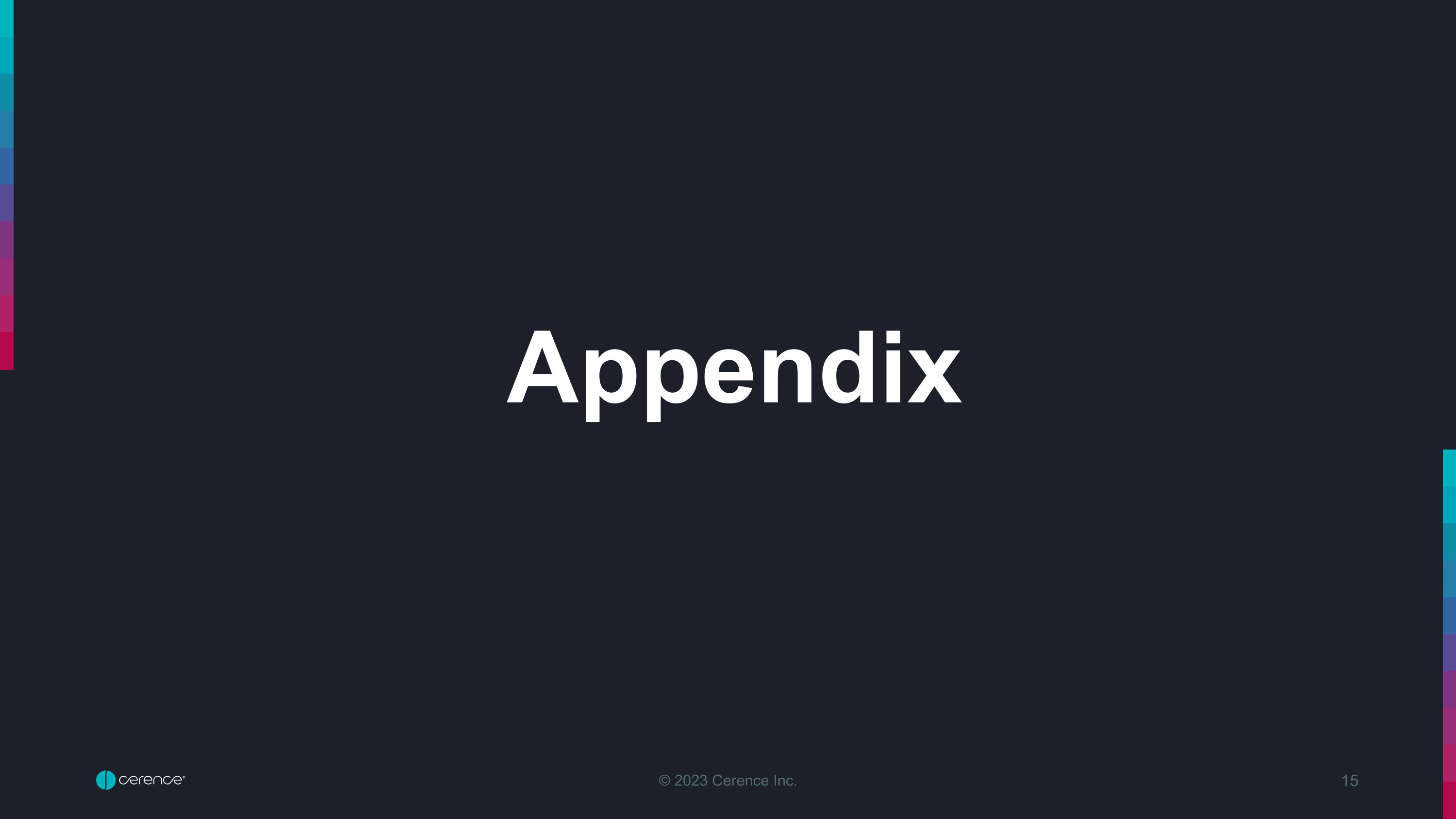
Appendix
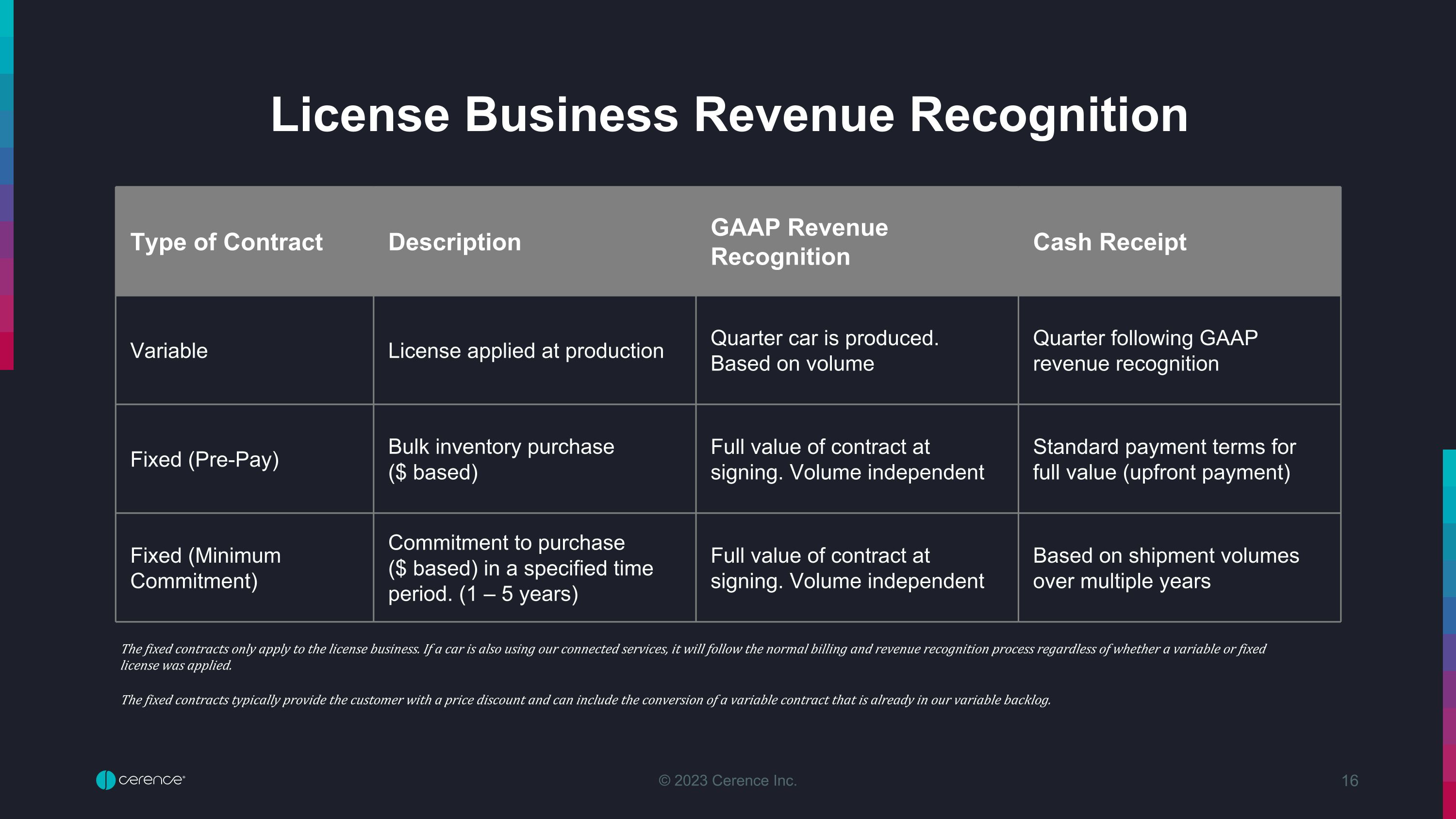
License Business Revenue Recognition Type of Contract Description GAAP Revenue Recognition Cash Receipt Variable License applied at production Quarter car is produced. Based on volume Quarter following GAAP revenue recognition Fixed (Pre-Pay) Bulk inventory purchase ($ based) Full value of contract at signing. Volume independent Standard payment terms for full value (upfront payment) Fixed (Minimum Commitment) Commitment to purchase ($ based) in a specified time period. (1 – 5 years) Full value of contract at signing. Volume independent Based on shipment volumes over multiple years The fixed contracts only apply to the license business. If a car is also using our connected services, it will follow the normal billing and revenue recognition process regardless of whether a variable or fixed license was applied. The fixed contracts typically provide the customer with a price discount and can include the conversion of a variable contract that is already in our variable backlog.

Connected and Professional Services Revenue Recognition Connected Services Typical Period GAAP Revenue Recognition Cash Receipt Subscription Term 1 – 5 years Amortized evenly over subscription period Billed/collected full amount at start of subscription period (value added to deferred revenue) Usage Contract(a),(b) 1 – 5 years Recognized at same time of billing based on actual usage Billed every quarter based on actual usage Customer Hosted(c) License Quarter in which license is delivered to customer Upon delivery (a) Approximately 30% of new connected revenue is usage based and is primarily with one customer (b) Usage can be defined by number of active users or number of monthly transactions (c) Customer Hosted is a software license that allows the customer to take possession of the software and enable hosting by the customer or a third-party Professional Services Period GAAP Revenue Recognition Cash Receipt Custom Design Services Ongoing Revenue is recognized over time based upon the progress towards completion of the project Billed/collected on milestone completion
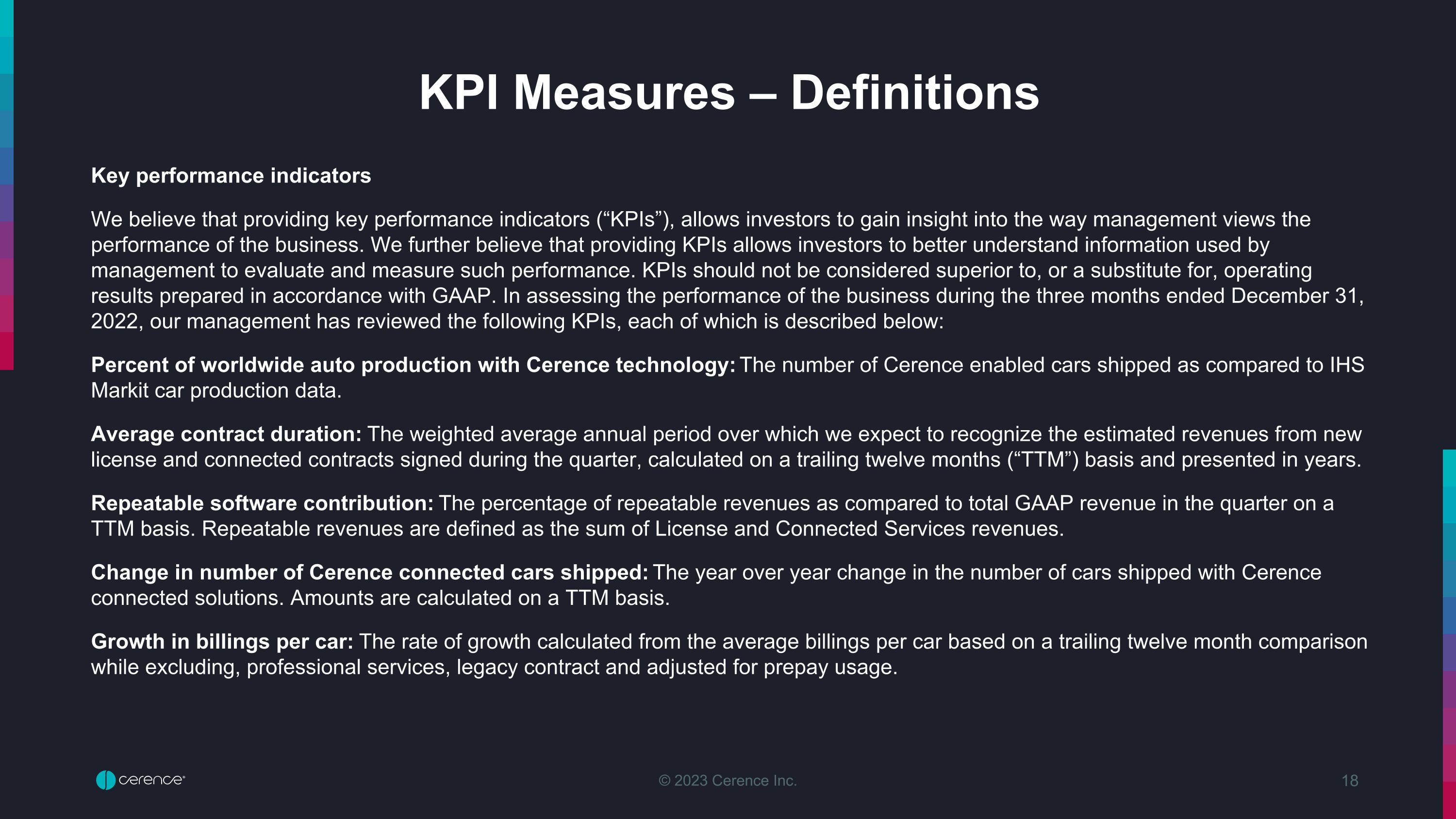
KPI Measures – Definitions Key performance indicators We believe that providing key performance indicators (“KPIs”), allows investors to gain insight into the way management views the performance of the business. We further believe that providing KPIs allows investors to better understand information used by management to evaluate and measure such performance. KPIs should not be considered superior to, or a substitute for, operating results prepared in accordance with GAAP. In assessing the performance of the business during the three months ended December 31, 2022, our management has reviewed the following KPIs, each of which is described below: Percent of worldwide auto production with Cerence technology: The number of Cerence enabled cars shipped as compared to IHS Markit car production data. Average contract duration: The weighted average annual period over which we expect to recognize the estimated revenues from new license and connected contracts signed during the quarter, calculated on a trailing twelve months (“TTM”) basis and presented in years. Repeatable software contribution: The percentage of repeatable revenues as compared to total GAAP revenue in the quarter on a TTM basis. Repeatable revenues are defined as the sum of License and Connected Services revenues. Change in number of Cerence connected cars shipped: The year over year change in the number of cars shipped with Cerence connected solutions. Amounts are calculated on a TTM basis. Growth in billings per car: The rate of growth calculated from the average billings per car based on a trailing twelve month comparison while excluding, professional services, legacy contract and adjusted for prepay usage.

Non-GAAP Financial Measures – Definitions Discussion of Non-GAAP Financial Measures We believe that providing the non-GAAP information in addition to the GAAP presentation, allows investors to view the financial results in the way management views the operating results. We further believe that providing this information allows investors to not only better understand our financial performance, but more importantly, to evaluate the efficacy of the methodology and information used by management to evaluate and measure such performance. The non-GAAP information should not be considered superior to, or a substitute for, financial statements prepared in accordance with GAAP. We utilize a number of different financial measures, both GAAP and non-GAAP, in analyzing and assessing the overall performance of the business, for making operating decisions and for forecasting and planning for future periods. While our management uses these non-GAAP financial measures as a tool to enhance their understanding of certain aspects of our financial performance, our management does not consider these measures to be a substitute for, or superior to, the information provided by GAAP financial statements. Consistent with this approach, we believe that disclosing non-GAAP financial measures to the readers of our financial statements provides such readers with useful supplemental data that, while not a substitute for GAAP financial statements, allows for greater transparency in the review of our financial and operational performance. In assessing the overall health of the business during the three months ending December 31, 2022 and 2021, our management has either included or excluded the following items in general categories, each of which is described below. Adjusted EBITDA Adjusted EBITDA is defined as net income attributable to Cerence Inc. before net income (loss) attributable to income tax (benefit) expense, other income (expense) items, net, depreciation and amortization expense, and excluding acquisition-related costs, amortization of acquired intangible assets, stock-based compensation, and restructuring and other costs, net or impairment charges related to fixed and intangible assets and gains or losses on the sale of long-lived assets, if any. From time to time we may exclude from Adjusted EBITDA the impact of events, gains, losses or other charges (such as significant legal settlements) that affect the period-to-period comparability of our operating performance. Other income (expense) items, net include interest expense, interest income, and other income (expense), net (as stated in our Condensed Consolidated Statement of Operations). Our management and Board of Directors use this financial measure to evaluate our operating performance. It is also a significant performance measure in our annual incentive compensation programs.
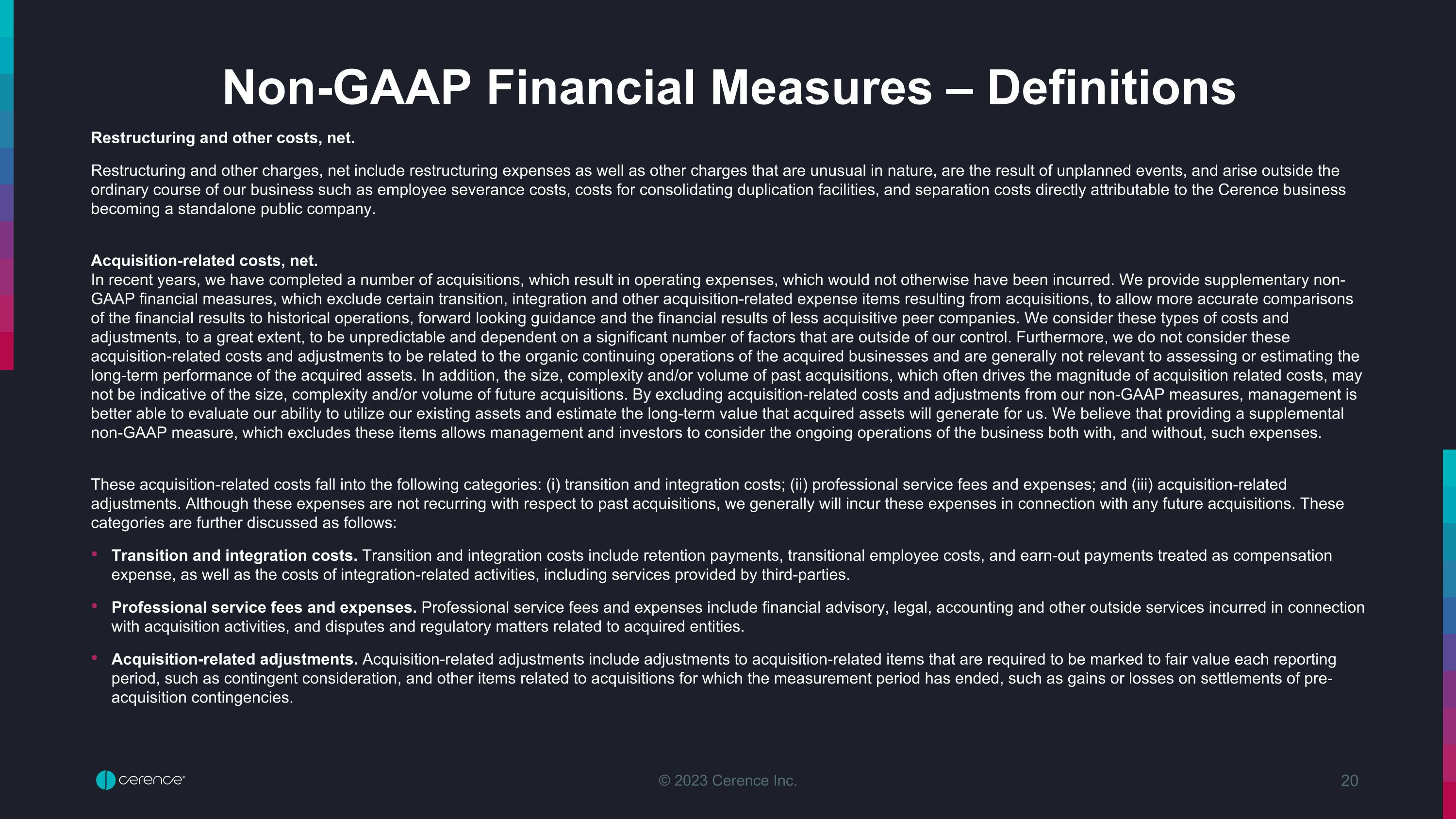
Non-GAAP Financial Measures – Definitions Restructuring and other costs, net. Restructuring and other charges, net include restructuring expenses as well as other charges that are unusual in nature, are the result of unplanned events, and arise outside the ordinary course of our business such as employee severance costs, costs for consolidating duplication facilities, and separation costs directly attributable to the Cerence business becoming a standalone public company. Acquisition-related costs, net. In recent years, we have completed a number of acquisitions, which result in operating expenses, which would not otherwise have been incurred. We provide supplementary non-GAAP financial measures, which exclude certain transition, integration and other acquisition-related expense items resulting from acquisitions, to allow more accurate comparisons of the financial results to historical operations, forward looking guidance and the financial results of less acquisitive peer companies. We consider these types of costs and adjustments, to a great extent, to be unpredictable and dependent on a significant number of factors that are outside of our control. Furthermore, we do not consider these acquisition-related costs and adjustments to be related to the organic continuing operations of the acquired businesses and are generally not relevant to assessing or estimating the long-term performance of the acquired assets. In addition, the size, complexity and/or volume of past acquisitions, which often drives the magnitude of acquisition related costs, may not be indicative of the size, complexity and/or volume of future acquisitions. By excluding acquisition-related costs and adjustments from our non-GAAP measures, management is better able to evaluate our ability to utilize our existing assets and estimate the long-term value that acquired assets will generate for us. We believe that providing a supplemental non-GAAP measure, which excludes these items allows management and investors to consider the ongoing operations of the business both with, and without, such expenses. These acquisition-related costs fall into the following categories: (i) transition and integration costs; (ii) professional service fees and expenses; and (iii) acquisition-related adjustments. Although these expenses are not recurring with respect to past acquisitions, we generally will incur these expenses in connection with any future acquisitions. These categories are further discussed as follows: Transition and integration costs. Transition and integration costs include retention payments, transitional employee costs, and earn-out payments treated as compensation expense, as well as the costs of integration-related activities, including services provided by third-parties. Professional service fees and expenses. Professional service fees and expenses include financial advisory, legal, accounting and other outside services incurred in connection with acquisition activities, and disputes and regulatory matters related to acquired entities. Acquisition-related adjustments. Acquisition-related adjustments include adjustments to acquisition-related items that are required to be marked to fair value each reporting period, such as contingent consideration, and other items related to acquisitions for which the measurement period has ended, such as gains or losses on settlements of pre-acquisition contingencies.
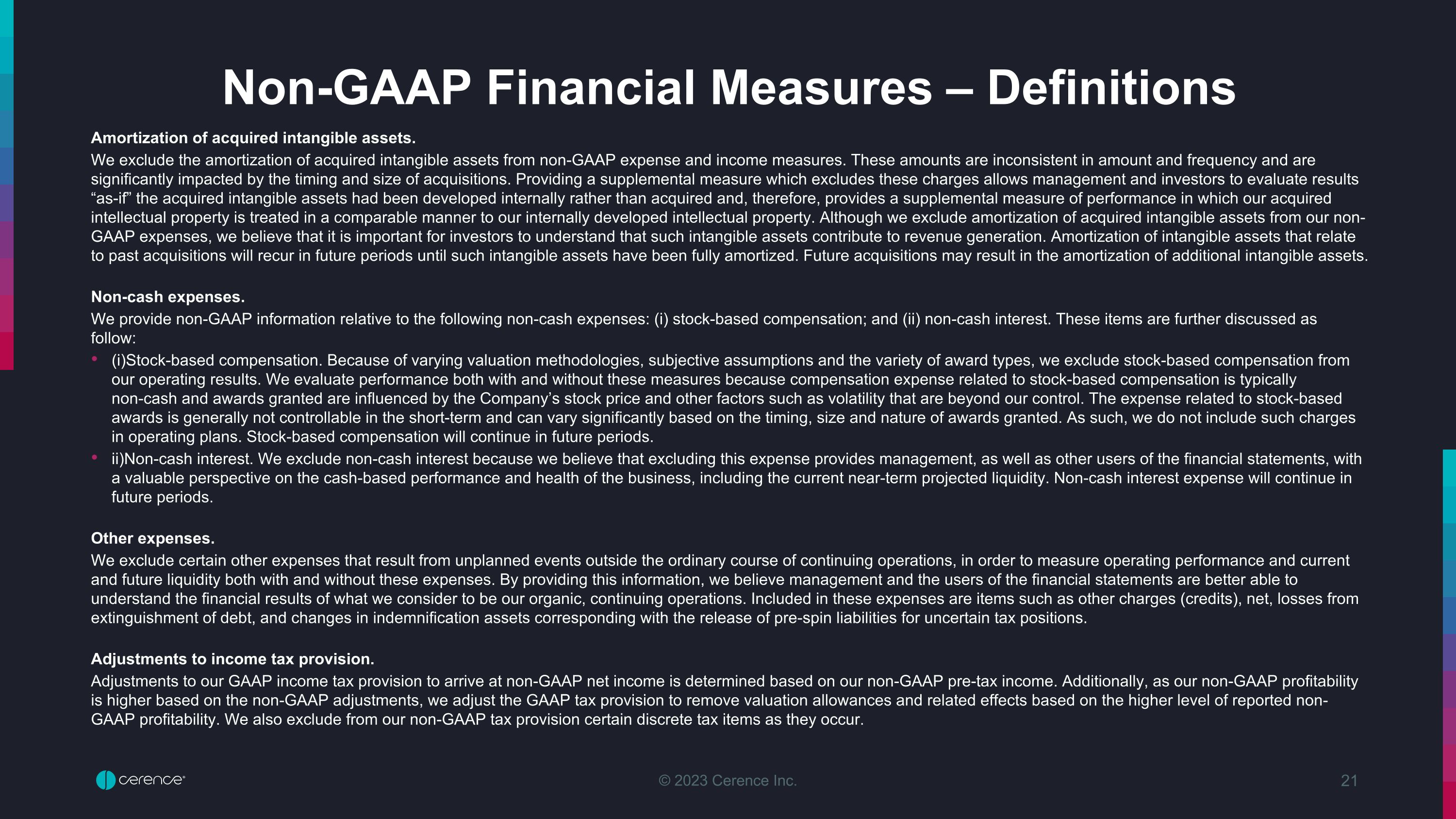
Non-GAAP Financial Measures – Definitions Amortization of acquired intangible assets. We exclude the amortization of acquired intangible assets from non-GAAP expense and income measures. These amounts are inconsistent in amount and frequency and are significantly impacted by the timing and size of acquisitions. Providing a supplemental measure which excludes these charges allows management and investors to evaluate results “as-if” the acquired intangible assets had been developed internally rather than acquired and, therefore, provides a supplemental measure of performance in which our acquired intellectual property is treated in a comparable manner to our internally developed intellectual property. Although we exclude amortization of acquired intangible assets from our non-GAAP expenses, we believe that it is important for investors to understand that such intangible assets contribute to revenue generation. Amortization of intangible assets that relate to past acquisitions will recur in future periods until such intangible assets have been fully amortized. Future acquisitions may result in the amortization of additional intangible assets. Non-cash expenses. We provide non-GAAP information relative to the following non-cash expenses: (i) stock-based compensation; and (ii) non-cash interest. These items are further discussed as follow: (i)Stock-based compensation. Because of varying valuation methodologies, subjective assumptions and the variety of award types, we exclude stock-based compensation from our operating results. We evaluate performance both with and without these measures because compensation expense related to stock-based compensation is typically non-cash and awards granted are influenced by the Company’s stock price and other factors such as volatility that are beyond our control. The expense related to stock-based awards is generally not controllable in the short-term and can vary significantly based on the timing, size and nature of awards granted. As such, we do not include such charges in operating plans. Stock-based compensation will continue in future periods. ii)Non-cash interest. We exclude non-cash interest because we believe that excluding this expense provides management, as well as other users of the financial statements, with a valuable perspective on the cash-based performance and health of the business, including the current near-term projected liquidity. Non-cash interest expense will continue in future periods. Other expenses. We exclude certain other expenses that result from unplanned events outside the ordinary course of continuing operations, in order to measure operating performance and current and future liquidity both with and without these expenses. By providing this information, we believe management and the users of the financial statements are better able to understand the financial results of what we consider to be our organic, continuing operations. Included in these expenses are items such as other charges (credits), net, losses from extinguishment of debt, and changes in indemnification assets corresponding with the release of pre-spin liabilities for uncertain tax positions. Adjustments to income tax provision. Adjustments to our GAAP income tax provision to arrive at non-GAAP net income is determined based on our non-GAAP pre-tax income. Additionally, as our non-GAAP profitability is higher based on the non-GAAP adjustments, we adjust the GAAP tax provision to remove valuation allowances and related effects based on the higher level of reported non-GAAP profitability. We also exclude from our non-GAAP tax provision certain discrete tax items as they occur.
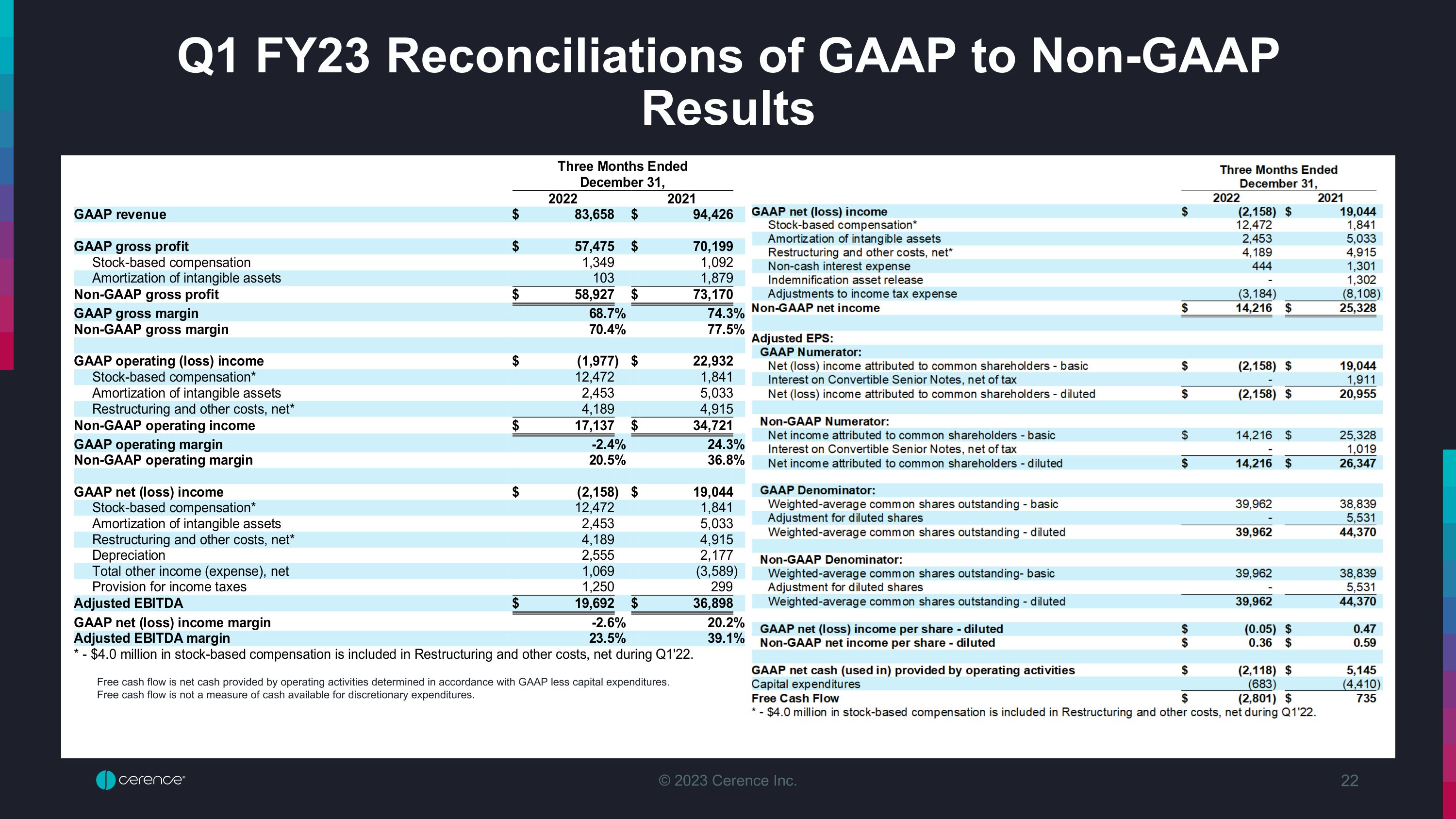
Q1 FY23 Reconciliations of GAAP to Non-GAAP Results Free cash flow is net cash provided by operating activities determined in accordance with GAAP less capital expenditures. Free cash flow is not a measure of cash available for discretionary expenditures. Q1 FY23 Reconciliations of GAAP to Non-GAAP Three Months Ended December 31, 2022 2021 GAAP revenue $83,658 $94,426 GAAP gross profit $57,475 $70,199 Stock-based compensation 1,349 1,092 Amortization of intangible assets 103 1,879 Non-GAAP gross profit $58,927 $73,170 GAAP gross margin 68.7% 74.3% Non-GAAP gross margin 70.4% 77.5% GAAP operating (loss) income $(1,977) $22,932 Stock-based compensation* 12,472 1,841 Amortization of intangible assets 2,453 5,033 Restructuring and other costs, net* 4,189 4,915 Non-GAAP operating income $17,137 $34,721 GAAP operating margin -2.4% 24.3% Non-GAAP operating margin 20.5% 36.8% GAAP net (loss) income $(2,158) $19,044 Stock-based compensation* 12,472 1,841 Amortization of intangible assets 2,453 5,033 Restructuring and other costs, net* 4,189 4,915 Depreciation 2,555 2,177 Total other income (expense), net 1,069 (3,589) Provision for income taxes 1,250 299 Adjusted EBITDA $19,692 $36,898 GAAP net (loss) income margin -2.6% 20.2% Adjusted EBITDA margin 23.5% 39.1% * - $4.0 million in stock-based compensation is included in Restructuring and other costs, net during Q1'22. Results Three Months Ended December 31, 2022 2021 GAAP net (loss) income $(2,158) $19,044 Stock-based compensation* 12,472 1,841 Amortization of intangible assets 2,453 5,033 Restructuring and other costs, net* 4,189 4,915 Non-cash interest expense 444 1,301 Indemnification asset release - 1,302 Adjustments to income tax expense (3,184) (8,108) Non-GAAP net income $14,216 $25,328 Adjusted EPS: GAAP Numerator: Net (loss) income attributed to common shareholders - basic $(2,158) $19,044 Interest on Convertible Senior Notes, net of tax - 1,911 Net (loss) income attributed to common shareholders - diluted $(2,158) $20,955 Non-GAAP Numerator: Net income attributed to common shareholders - basic $14,216 $25,328 Interest on Convertible Senior Notes, net of tax - 1,019 Net income attributed to common shareholders - diluted $14,216 $26,347 GAAP Denominator: Weighted-average common shares outstanding - basic 39,962 38,839 Adjustment for diluted shares - 5,531 Weighted-average common shares outstanding - diluted 39,962 44,370 Non-GAAP Denominator: Weighted-average common shares outstanding- basic 39,962 38,839 Adjustment for diluted shares - 5,531 Weighted-average common shares outstanding - diluted 39,962 44,370 GAAP net (loss) income per share - diluted $(0.05) $0.47 Non-GAAP net income per share - diluted $0.36 $0.59 GAAP net cash (used in) provided by operating activities $(2,118) $5,145 Capital expenditures (683) (4,410) Free Cash Flow $(2,801) $735 * - $4.0 million in stock-based compensation is included in Restructuring and other costs, net during Q1'22.
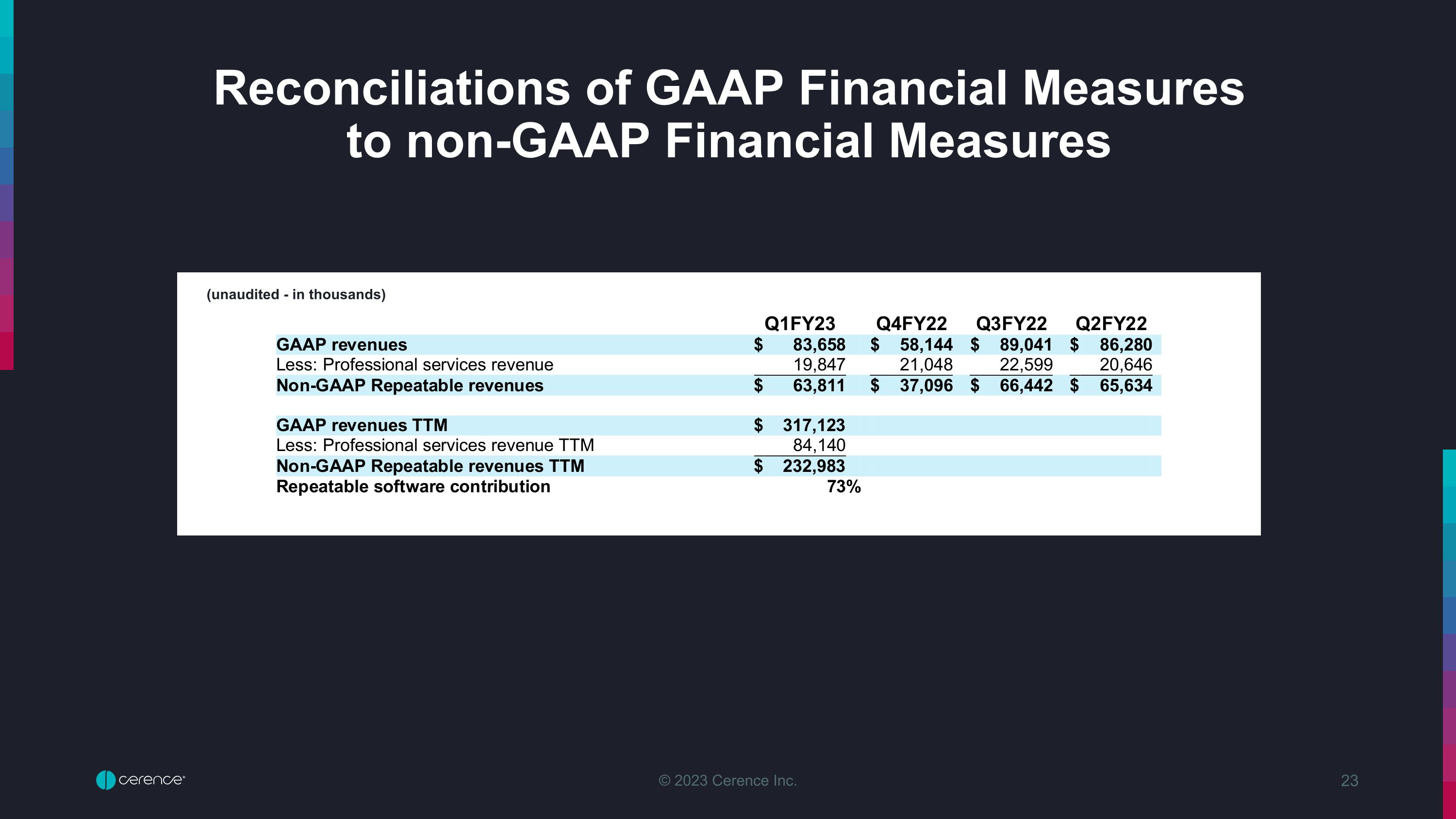
Reconciliations of GAAP Financial Measures to non-GAAP Financial Measures (unaudited - in thousands) Q1FY23 Q4FY22 Q3FY22 Q2FY22 GAAP revenues $83,658 $58,144 $89,041 $86,280 Less: Professional services revenue 19,847 21,048 22,599 20,646 Non-GAAP Repeatable revenues $63,811 $37,096 $66,442 $65,634 GAAP revenues TTM $317,123 Less: Professional services revenue TTM 84,140 Non-GAAP Repeatable revenues TTM $232,983 Repeatable software contribution 73%

Q2 FY23 and Full Year FY23 Reconciliations of GAAP to non-GAAP Guidance (unaudited - in thousands) Q2 2023 FY2023 Low High Low High GAAP revenue $64,000 $68,000 $275,000 $290,000 GAAP gross profit $38,200 $42,200 $172,300 $187,300 Stock-based compensation 1,300 1,300 5,400 5,400 Amortization of intangible assets 100 100 400 400 Non-GAAP gross profit $39,600 $43,600 $178,100 $193,100 GAAP gross margin 60% 62% 63% 65% Non-GAAP gross margin 62% 64% 65% 67% GAAP operating loss $(23,700) $(20,200) $(49,500) $(42,500) Stock-based compensation 12,400 12,400 49,500 49,500 Amortization of intangible assets 2,500 2,500 6,100 6,100 Restructuring and other costs, net 6,500 6,500 9,800 9,800 Non-GAAP operating (loss) income $(2,300) $1,200 $15,900 $22,900 GAAP operating margin -37% -30% -18% -15% Non-GAAP operating margin -4% 2% 6% 8% GAAP net loss $(32,300) $(28,800) $(69,700) $(62,700) Stock-based compensation 12,400 12,400 49,500 49,500 Amortization of intangible assets 2,500 2,500 6,100 6,100 Restructuring and other costs, net 6,500 6,500 9,800 9,800 Depreciation 3,000 3,000 11,100 11,100 Total other income (expense), net (2,700) (2,700) (7,100) (7,100) Provision for income taxes 5,900 5,900 13,100 13,100 Adjusted EBITDA $700 $4,200 $27,000 $34,000 GAAP net loss margin -50% -42% -25% -22% Adjusted EBITDA margin 1% 6% 10% 12%

(unaudited - in thousands) Q2 FY23 and FY23 Reconciliations of GAAP to Non-GAAP Guidance Q2 2023 FY2023 Low High Low High GAAP net loss $(32,300) $(28,800) $(69,700) $(62,700) Stock-based compensation 12,400 12,400 49,500 49,500 Amortization of intangibles 2,500 2,500 6,100 6,100 Restructuring and other costs, net 6,500 6,500 9,800 9,800 Non-cash interest expense 500 500 1,900 1,900 Adjustments to income tax expense 3,200 2,400 (600) (2,100) Non-GAAP net (loss) income $(7,200) $(4,500) $(3,000) $2,500 Adjusted EPS: GAAP Numerator: Net loss attributed to common shareholders $(32,300) $(28,800) $(69,700) $(62,700) Non-GAAP Numerator: Net (loss) income attributed to common shareholders $(7,200) $(4,500) $(3,000) $2,500 GAAP Denominator: Weighted-average common shares outstanding - basic and diluted 40,200 40,200 40,200 40,200 Non-GAAP Denominator: Weighted-average common shares outstanding - basic and diluted 40,200 40,200 40,200 40,200 GAAP net loss per share - diluted $(0.80) $(0.72) $(1.73) $(1.56) Non-GAAP net (loss) income per share - diluted $(0.18) $(0.11) $(0.07) $0.06